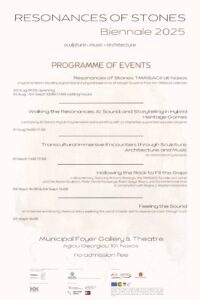Resonances of Stones Biennale
 Resonances of Stones Biennale Naxos 2025
Resonances of Stones Biennale Naxos 2025
Inspired and designed by the Mantinea Institute, and organised in collaboration with the Polish Society for Aesthetics and TMMSAC©, a site-responsive biennial took place on Naxos from 30th August to 4th September. It explored contemporary art, music, and architecture across historic landmarks and landscapes of Naxos. In this extraordinary cultural centre, ancient marble and emery quarries, fertile vineyards, orchards, and gardens have witnessed its inhabitants’ resistance to the Persians, the Ottoman Empire, and a century-long cohabitation with the Venetians. The Biennale’s exhibition, international symposium, performances, workshops, and guided experiences, complemented by virtual and augmented-reality pathways, allowed audiences worldwide to take part in a dialogue between this unique cultural context and African contemporary sculpture, through a sound and musical intervention of the Resonances of Stones project. Thus, the program of the Biennale facilitated an original intercultural exchange and learning, modelling a replicable framework for integrating art with heritage spaces and soundscapes to generate both cultural and educational impact.

At the heart of the project lies the concept of Resonance:
Every space, substance, and object interacts with sound through complex processes of reflection, vibration, and reverberation. In historical sites, this continuous dialogue between architecture, matter, sound, and memory transforms the space itself into an integral part of the perceptual experience: a musical piece performed within such a space incorporates unique acoustic characteristics and historical stratifications, inseparable from the place and impossible to reproduce elsewhere.
Architectural proportions, the transformations that time has etched onto stones and building materials, and their location within a specific soundscape all enter into dialogue with the works—musical and visual—placed within them, generating opportunities for discovery and wonder.
Reconstructing these spaces virtually, especially distressed historical sites, requires restoring not only their architectural form, but also their original sonic identity. It is a way of reactivating their comprehensive sensory and conceptual complexity, offering the audience an integral and profound perception of its meaning, in dialogue with time.
In an immersive experience of the interaction between the substantial and conceptual dimensions, an additional resonance is generated: the emotional response of the audience, arising from the tension between the site’s embodied memory and its present perception. This amplifies and revives the site, and restores a sense that continues to resonate over time.
The programme of the Biennale:
- Resonances of Stones: TMMSAC© at Naxos – sculpture • music • architecture
a hybrid exhibition blending augmented and physical experience of Kenyan Sculpture from the TMMSAC© collection • 30 Aug 19:30 opening • 31 Aug – 04 Sept 10:00-17:00 visiting hours • no admission fee
- Transcultural Immersive Encounters through Sculpture, Architecture, and Music
an International symposium • 01 Sept 11:00-17:30
- Walking the Resonances: AI, Sound, and Storytelling in Hybrid Heritage Games
a lecture by Dr. Dorota Hrycak-Krzyżanowska and a workshop with an interactive augmented educational game • 31 Aug 16:00-17:30
- Hollowing the Rock to Fill the Gaps
a documentary featuring Mutuma Marangu, the TMMSAC© founder and owner and the Master Sculptors: Peter Oendo Kenyanya, Robin Okeyo Mbera, and Gerard Motondi Oroo in conversation with Bogna J. Gladden-Obidzińska • 02 Sept 16:00 & 04 Sept 16:00
- Feeling the Sound
an immersive workshop by Gianluca Aresu, exploring the use of a haptic vest to experience music through touch • 03 Sept 16:00
Venue: Municipal Foyer Gallery & Theatre, Agiou Georgiou 101, Chora, Naxos, Greece
These activities were part of the CAPHE project, which has received funding from the European Union’s Horizon Europe strategic innovation programme under grant agreement no. 101086391. The perspectives and opinions expressed herein belong to their authors and do not necessarily reflect those of the European Union or the European Executive Agency. Neither the European Union nor the funding institution is responsible for them.
![]()
